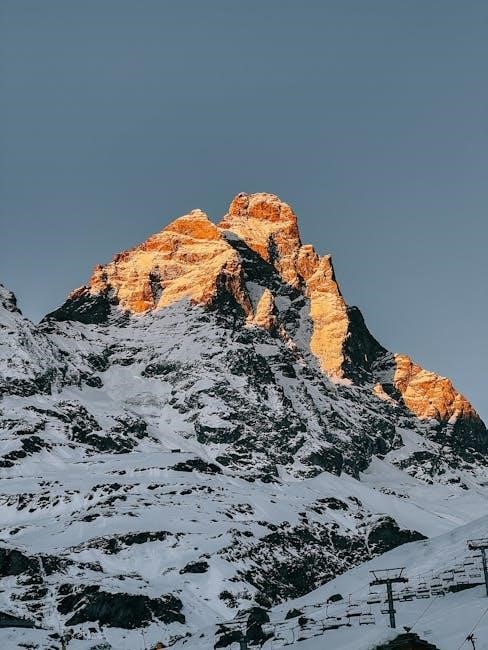The Matterhorn is one of the most iconic mountains in the world, attracting climbers with its striking pyramidal peak and challenging routes like the Hörnli Ridge;
1.1 Why the Matterhorn is a iconic climbing destination
1.1 Why the Matterhorn is a Iconic Climbing Destination
The Matterhorn is a legendary climbing destination due to its striking pyramidal peak and challenging routes like the Hörnli Ridge. Its iconic status stems from its unique shape, rich climbing history, and breathtaking Alpine scenery. Climbers are drawn to its technically demanding routes, making it a benchmark for mountaineering skills. The mountain’s accessibility from Zermatt and its reputation as one of the most photographed peaks in the world further enhance its allure. Many climbers aspire to conquer it, despite its formidable reputation for difficulty and risk.
1.2 Brief history of Matterhorn climbs
1.2 Brief History of Matterhorn Climbs
The Matterhorn’s first ascent occurred in 1865 by a team led by Edward Whymper, marking a pivotal moment in mountaineering history. Since then, it has become a symbol of climbing excellence. Early climbers faced immense challenges due to limited equipment and unpredictable weather. The mountain’s popularity grew, with the Hörnli Ridge becoming the most frequently used route. Over the years, climbers have tackled its slopes, with the season typically starting in July. Despite its dangers, the Matterhorn remains a timeless attraction for adventurers worldwide.
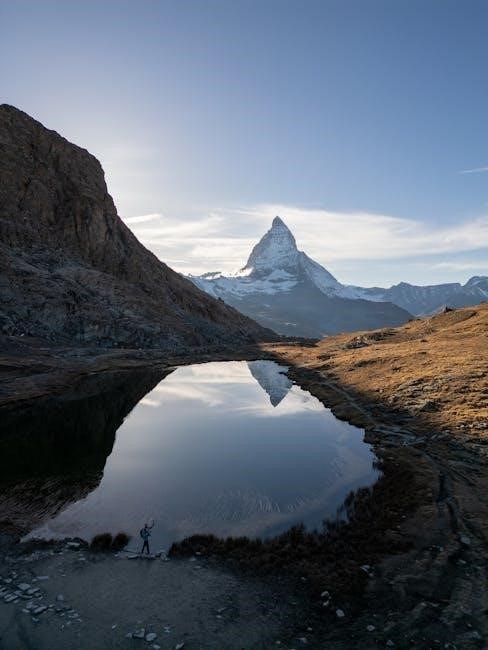
Climbing Routes on the Matterhorn
The Matterhorn offers multiple climbing routes, with the Hörnli Ridge being the most popular. Other routes vary in difficulty, catering to different skill levels, guided by experts.
2.1 Overview of the Hörnli Ridge route
The Hörnli Ridge is the most popular route to the Matterhorn’s summit, known for its challenging terrain and breathtaking views. Starting from the Hörnli Hut, climbers ascend mixed rock and ice, navigating exposed ridges and steep sections. The route is technically demanding, requiring crampons, ice axes, and strong physical endurance. Despite its difficulty, the Hörnli Ridge remains a favorite due to its direct path to the summit. Climbers typically complete the ascent and descent in two days, with guided groups ensuring safety and efficiency on this iconic climb.
2.2 Other notable routes and their characteristics
Beyond the Hörnli Ridge, the Matterhorn offers several other challenging routes, each with unique characteristics. The Lion Ridge, or Lyskamm Route, is known for its steep rock and ice sections, offering a more technical alternative. The Furggen Ridge provides a quieter experience with dramatic views, though it’s less frequently climbed due to its remote start. Each route demands advanced mountaineering skills and physical stamina, making them suitable for experienced climbers seeking diverse challenges on this iconic mountain. Guides often recommend these routes for those looking to avoid crowds while still experiencing the Matterhorn’s majesty.
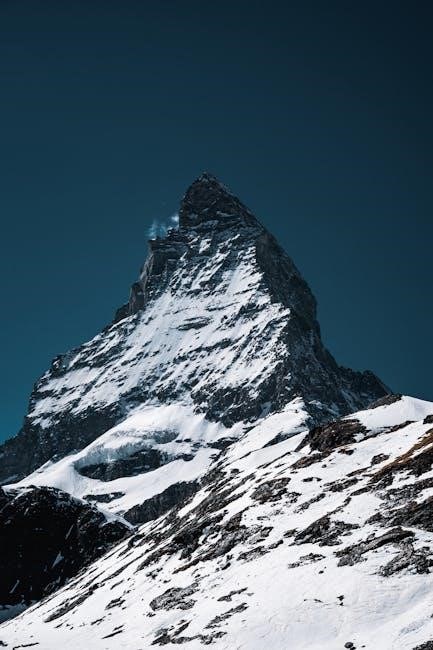
Role of a Guide in a Matterhorn Climb
A certified guide provides essential expertise, ensuring a safe and successful ascent by navigating complex routes, managing risks, and offering critical support throughout the climb.
3.1 Importance of hiring a certified guide
Hiring a certified guide is crucial for a safe and successful Matterhorn climb. Guides possess extensive knowledge of the mountain, including the best routes and potential hazards. They ensure climbers navigate challenging terrain, manage risks, and make informed decisions. A guide’s expertise significantly reduces accidents and enhances the overall experience. Climbing without a certified guide increases the likelihood of accidents, as the Matterhorn’s unpredictable conditions require professional oversight. Their guidance is invaluable for both novice and experienced climbers, ensuring a safer and more rewarding ascent.
3.2 Responsibilities of a guide during the climb
A certified guide on the Matterhorn is responsible for route navigation, ensuring climbers stay on track and avoid hazards. They assess clients’ skills and physical condition, providing personalized support. Guides conduct safety briefings, check equipment, and manage rope work. They make critical decisions about weather, snow conditions, and potential risks. In emergencies, guides implement rescue protocols and first aid. Their expertise ensures a safer climb, allowing clients to focus on the ascent while adhering to environmental practices. A guide’s leadership is essential for a successful and safe Matterhorn experience.
Physical and Technical Requirements
Climbing the Matterhorn requires high cardiovascular endurance, strength, and agility. Technical skills like rope work, ice climbing, and navigating steep terrain are essential for a successful ascent.
4.1 Cardiovascular endurance needed for the climb
Climbing the Matterhorn demands exceptional cardiovascular endurance due to its high altitude and steep terrain. Climbers must maintain stamina for long, demanding days. Training should focus on building heart and lung capacity through activities like running, cycling, or high-intensity interval training. Strong endurance ensures sustained energy levels for the ascent and helps manage altitude-related challenges. Proper conditioning is crucial to tackle the Hörnli Ridge and other routes effectively, making cardiovascular fitness a cornerstone of preparation for this iconic climb.
4.2 Technical skills required for the ascent
The Matterhorn climb demands advanced technical skills, including proficiency in rock and ice climbing, rope work, and anchor placement. Climbers must master cramponing, ice axe techniques, and crevasse rescue methods. Strong knowledge of glacier travel and mixed terrain navigation is essential. Experience with multi-pitch climbing and the ability to handle exposed routes are critical. While guides can assist, climbers should possess a solid foundation in mountaineering techniques to safely tackle the Hörnli Ridge and other challenging routes on the Matterhorn.
Training and Preparation
A rigorous training regimen is essential for the Matterhorn climb, focusing on building cardiovascular endurance, muscular strength, and mental resilience. A structured plan tailored to your fitness level ensures readiness.
5.1 Recommended training regimen for beginners
Beginners should start with a structured, 6-12 month training plan focusing on cardiovascular endurance, muscular strength, and technical skills. Incorporate weekly cardio sessions, such as running or cycling, to build stamina. Strength training should target core, legs, and upper body. Practice hiking with a loaded backpack to simulate climb conditions. Technical skills, like rope work and crampon use, should be honed through introductory mountaineering courses. Gradually increase intensity and duration to adapt to high-altitude demands. Working with a certified guide or mentor is highly recommended.
5.2 Building strength and endurance for the climb
Building strength and endurance is crucial for tackling the Matterhorn. Focus on a structured routine that includes high-intensity interval training (HIIT) for cardiovascular fitness and strength exercises targeting legs, core, and upper body. Incorporate activities like squats, lunges, and step-ups to build muscular endurance. Gradually increase the intensity and duration of workouts to simulate the climb’s physical demands. Aim for long hikes with a heavy backpack to acclimate to the weight and terrain. Consistency and progressive overload are key to achieving the necessary stamina and strength.

Permits and Regulations
Climbing the Matterhorn requires proper permits and adherence to local regulations. Ensure you obtain necessary permits in Zermatt and hire a certified guide for compliance.
6.1 Requirements for climbing permits in Zermatt
To climb the Matterhorn, you must obtain a permit from Zermatt authorities. Ensure you have proper documentation, including proof of insurance and guide certification if required. Hiring a certified guide is often mandatory for inexperienced climbers. Permits may vary depending on the season and route. Early season climbers (June) may need special permits due to conditions. Environmental permits for waste disposal are also essential. Always check with local authorities for the most up-to-date regulations before your climb.
Best Time to Climb the Matterhorn
The optimal season for climbing the Matterhorn is mid-July to late August, when weather conditions are stable and snow is manageable.
7.1 Climbing season and optimal weather conditions
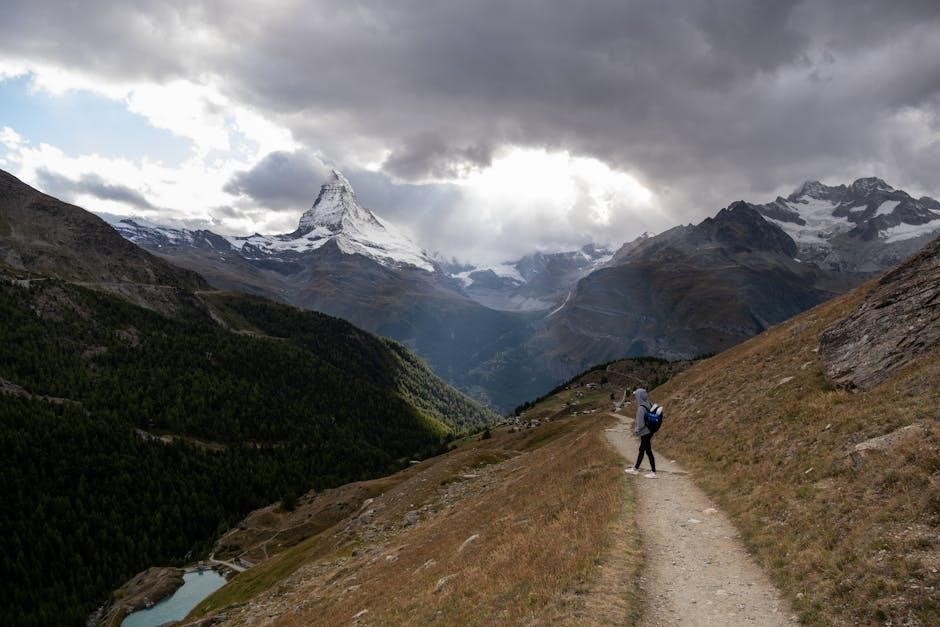
The Matterhorn climbing season typically begins in mid-July and extends through late August, with the most stable weather conditions often found in July and early August. During this period, temperatures are warmer, and snow conditions are more manageable, reducing avalanche risks. However, climbers should be prepared for unpredictable mountain weather, including sudden storms. It’s crucial to check local forecasts and consider the expertise of a guide to navigate these conditions safely. Proper timing and preparation are key to a successful ascent.
Safety Measures and Risks
Climbing the Matterhorn involves significant risks, including rockfall, overcrowded routes, and unpredictable weather. Hiring a certified guide and using proper safety equipment is essential to mitigate these dangers.
8.1 Common hazards on the Matterhorn
The Matterhorn poses several hazards, including steep and unstable terrain prone to rockfall, icy surfaces, and unpredictable weather conditions. Congested routes, particularly on the Hörnli Ridge, increase the risk of accidents. Climbers must also contend with high altitudes, which can cause altitude sickness. Additionally, the mountain’s exposed nature makes it susceptible to sudden changes in weather, such as storms, which can further endanger climbers. These factors highlight the importance of careful preparation and experienced guidance when tackling the climb.
8.2 Emergency protocols and safety equipment
Climbing the Matterhorn requires strict adherence to safety protocols. Essential gear includes crampons, ice axes, ropes, and harnesses. Climbers must carry emergency beacons and communication devices. Guides are trained to assess risks and coordinate rescues if needed. Emergency shelters and evacuation routes are established along common paths. Weather monitoring is critical to avoid sudden storms. Proper safety equipment and knowledge of emergency procedures are vital to minimize risks during the ascent. Always ensure your guide is certified and experienced in handling such situations.
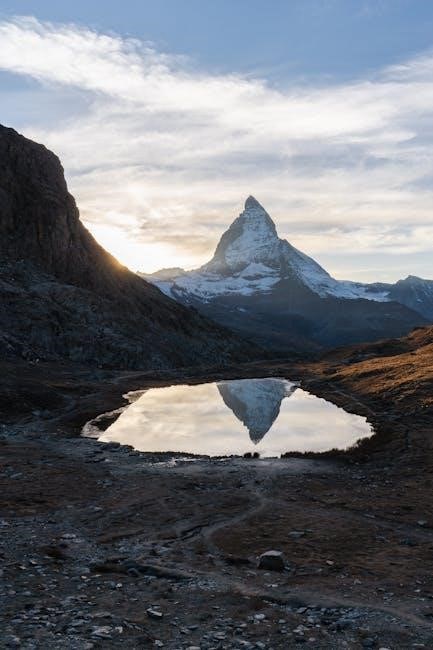
Climbing Itinerary
A typical Matterhorn climb spans two days, starting with acclimatization in Zermatt. Day one involves ascending to the Hörnli Hut, and day two includes an early morning summit attempt.
9.1 Typical 2-day climbing itinerary
A standard Matterhorn climb begins with acclimatization in Zermatt. Day one includes an early start, equipment checks, and ascent to the Hörnli Hut (3,260m), with afternoon rest. On day two, climbers rise around midnight for the summit push, navigating the Hörnli Ridge. The challenging climb involves steep rock, ice, and exposed terrain. After reaching the summit, climbers descend back to the hut and return to Zermatt, completing the adventure. This itinerary ensures climbers are well-prepared and guided safely throughout the ascent.
Cost of a Guided Climb
The average cost of hiring a certified guide for the Matterhorn ranges from $1,000 to $3,000, depending on the guide’s experience and the climb’s duration.
10.1 Average cost of hiring a guide
The average cost of hiring a certified guide for a Matterhorn climb ranges from $1,000 to $3,000, depending on the guide’s experience and the climb’s duration. Prices typically include logistical support, safety equipment, and expert guidance. Costs may vary based on the time of year, with peak season (July-August) often being more expensive. Climbers should also budget for additional expenses like gear rentals and accommodation in Zermatt. Ensure your guide is certified by a recognized organization like the IFMGA for safety and professionalism.
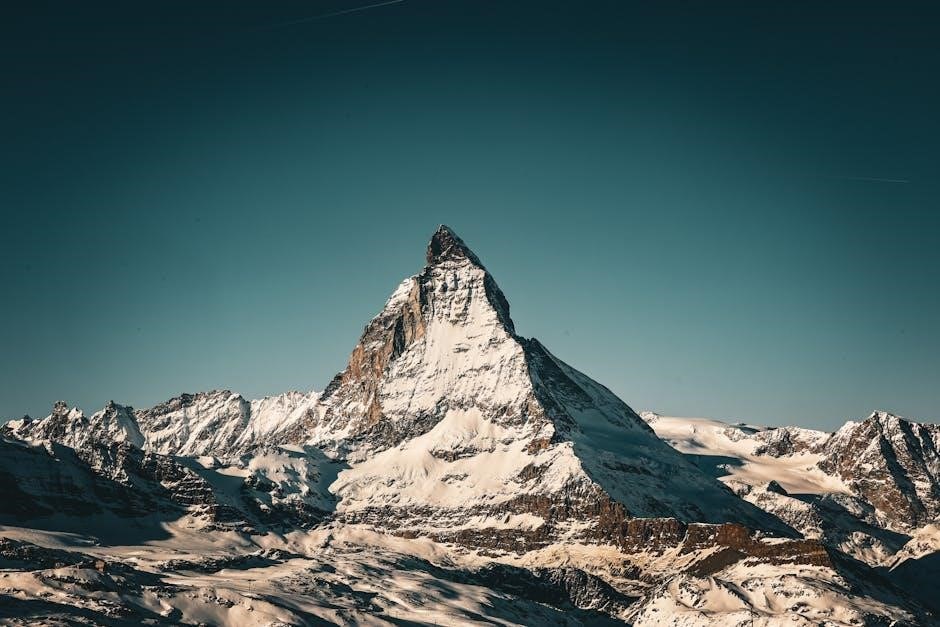
Essential Equipment for the Climb
Crampons, ice axes, helmets, ropes, and sturdy mountaineering boots are must-haves. Climbers should also carry layers, gloves, goggles, and a first-aid kit for safety and comfort.
11.1 Must-have gear for a successful ascent
A successful Matterhorn climb requires sturdy mountaineering boots, crampons, ice axes, helmets, and ropes. Climbers should also carry layers, gloves, goggles, and a first-aid kit. Proper gear ensures safety and comfort during the ascent, especially on icy and rocky terrain. It’s crucial to check the condition of all equipment before starting the climb to avoid malfunctions. Additionally, a backpack with essentials like water, snacks, and extra clothing is vital for enduring the challenging conditions on the mountain.
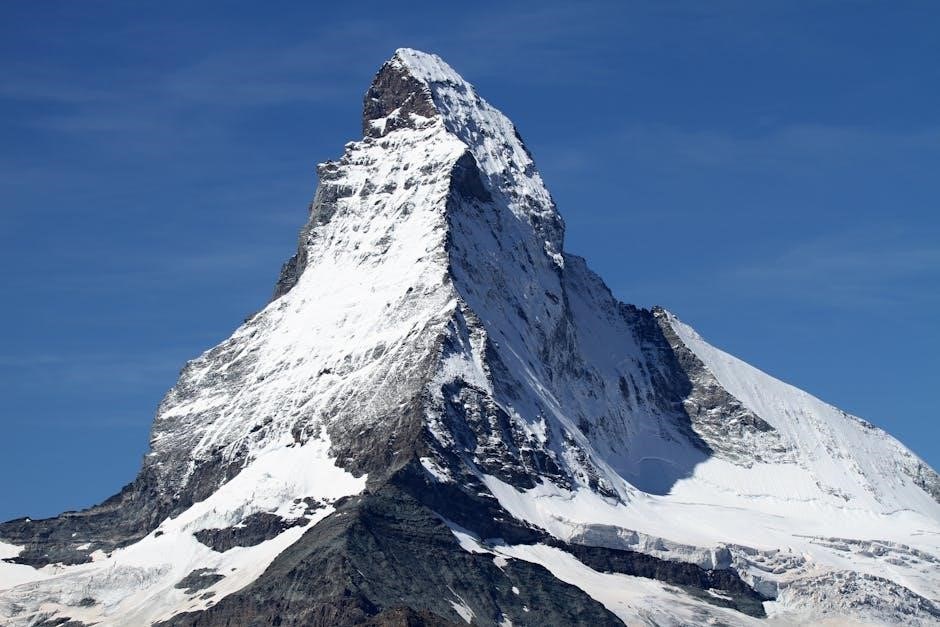
Environmental Impact
Climbing the Matterhorn impacts the fragile Alpine ecosystem, emphasizing the need for eco-friendly practices to preserve its natural beauty and biodiversity for future generations.
12.1 Eco-friendly practices for climbers
To minimize environmental impact, climbers should adopt sustainable practices such as carrying all waste, using biodegradable toiletries, and staying on designated trails. Avoid disturbing flora and fauna, as the Matterhorn’s ecosystem is fragile. Using local guides who adhere to eco-friendly protocols is crucial, as they understand the importance of preserving the mountain’s natural beauty. By respecting these practices, climbers contribute to the long-term conservation of the Alpine environment for future generations.
The Matterhorn guided climb is a once-in-a-lifetime adventure, offering breathtaking views and a sense of accomplishment. With proper preparation and expert guidance, climbers can safely conquer this iconic peak.
13.1 Final thoughts on the Matterhorn guided climb
The Matterhorn guided climb is a true test of endurance and skill, offering breathtaking views and a profound sense of achievement. With expert guidance, climbers navigate challenging routes like the Hörnli Ridge, making the experience both safe and unforgettable. The mountain’s iconic status and stunning landscapes leave a lasting impression; For many, reaching the summit is a pinnacle of personal achievement, embodying the spirit of adventure and resilience. The Matterhorn remains a timeless destination for climbers seeking to push their limits and connect with nature’s grandeur.
